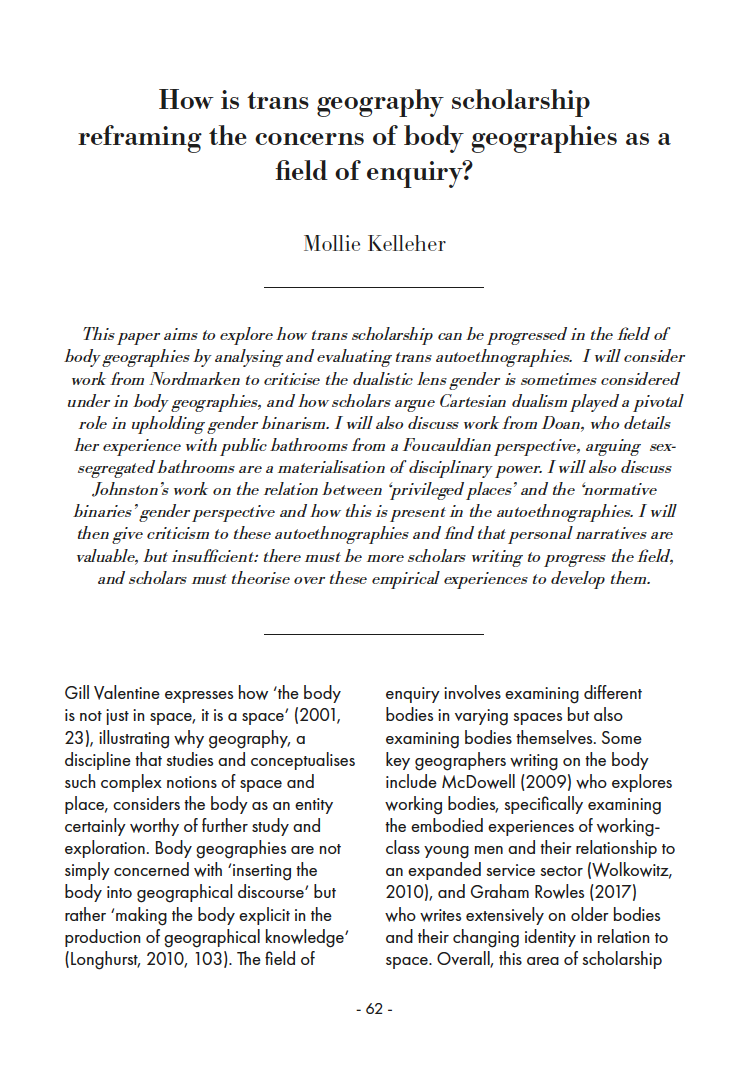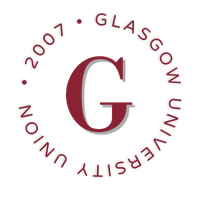How is trans geography scholarship reframing the concerns of body geographies as a field of enquiry?
DOI:
https://doi.org/10.36399/GroundingsUG.14.145Keywords:
Body Geometry, Transgender Studies, Autoethnography, Narrative Studies, Nordmarken, Normative Binary, Critical StudiesAbstract
This paper aims to explore how trans scholarship can be progressed in the field of body geographies by analysing and evaluating trans autoethnographies. I will consider work from Nordmarken to criticise the dualistic lens gender is sometimes considered under in body geographies, and how scholars argue Cartesian dualism played a pivotal role in upholding gender binarism. I will also discuss work from Doan, who details her experience with public bathrooms from a Foucauldian perspective, arguing sex-segregated bathrooms are a materialisation of disciplinary power. I will also discuss Johnston’s work on the relation between ‘privileged places’ and the ‘normative binaries’ gender perspective and how this is present in the autoethnographies. I will then give criticism to these autoethnographies and find that personal narratives are valuable, but insufficient: there must be more scholars writing to progress the field, and scholars must theorise over these empirical experiences to develop them.
References
Ågerfalk, J. (2014) “Insufficient theoretical contribution: A conclusive rationale for rejection?,” European Journal of Information Systems, 23(6), p 593–599. Available at: https://doi.org/10.1057/ejis.2014.35.
Beauchamp, T. (2009) “Artful Concealment and Strategic Visibility: Transgender Bodies and U.S. State Surveillance after 9/11,” Surveillance & Society, 6(4), p 356–366. Available at: https://doi.org/10.24908/ss.v6i4.3267.
Bender-Baird, K. (2016) “Peeing under surveillance: Bathrooms, gender policing, and hate violence,” Gender, Place & Culture, 23(7), p 983–988. Available at: https://doi.org/10.1080/0966369x.2015.1073699.
Boylorn , R. and Orbe , M. (2020) “Introduction ,” in Critical Autoethnography. 2nd. Routledge.
Browne , K. (2004) “Genderism and the bathroom problem: (re)materialising sexed sites, (re)creating sexed bodies,” Gender, Place & Culture, 11(3), p 331–346. Available at: https://doi.org/10.1080/0966369042000258668.
Browne, K. and Nash, C.J. (2010) Queer Methods and Methodologies: Intersecting Queer Theories and Social Science Research. Ashgate Publishing.
Butler, J. (1990) Gender trouble: Feminism and the Subversion of Identity. New York: Routledge.
Butz, D. and Besio, K. (2009) “Autoethnography,” Geography Compass, 3(5), p 1660–1674. Available at: https://doi.org/10.1111/j.1749-8198.2009.00279.x.
Chu, A.L. and Drager, E.H. (2019) “After trans studies,” TSQ: Transgender Studies Quarterly, 6(1), p 103–116. Available at: https://doi.org/10.1215/23289252-7253524.
Crewe, L. (2001) “The besieged body: Geographies of retailing and consumption,” Progress in Human Geography, 25(4), p 629–640. Available at: https://doi.org/10.1191/030913201682688986.
Doan, L. (2010) “The tyranny of gendered spaces – reflections from beyond the gender dichotomy,” Gender, Place & Culture, 17(5), p 635–654. Available at: https://doi.org/10.1080/0966369x.2010.503121.
Francis, B. (2008) “Engendering debate: How to formulate a political account of the divide between genetic bodies and discursive gender?,” Journal of Gender Studies, 17(3), p 211–223. Available at: https://doi.org/10.1080/09589230802204241.
Foucault, M. (2003 [1976]) “Society must be defended”: Lectures at the College de France, 1975-76. New York: Picador.
Gerdes, K. (2014) “Performativity,” TSQ: Transgender Studies Quarterly, 1(1-2), p 148–150. Available at: https://doi.org/10.1215/23289252-2399866.
Holland, S. (1995) “Descartes goes to Hollywood: Mind, body and gender in contemporary Cyborg Cinema,” Body & Society, 1(3-4), p 157–174. Available at: https://doi.org/10.1177/1357034x95001003009.
Hopkins, P (2019) “Social Geography II: Islamophobia, transphobia, and sizeism,” Progress in Human Geography, 44(3), p 583–594. Available at: https://doi.org/10.1177/0309132519833472.
Hyde, J.S. et al. (2019) “The future of sex and gender in psychology: Five challenges to the gender binary.,” American Psychologist, 74(2), p 171–193. Available at: https://doi.org/10.1037/amp0000307.
Johnston, L. (2016) “Gender and sexuality I: Genderqueer geographies?,” Progress in Human Geography, 40(5), p 668–678. Available at: https://doi.org/10.1177/0309132515592109.
Jones, S., Adams , T. and Ellis , C. (2016) Handbook of Autoethnography. New York: Taylor & Francis.
Konopka, K., Prusik, M. and Szulawski, M. (2019) “Two sexes, two genders only: Measuring attitudes toward transgender individuals in Poland,” Sex Roles, 82(9-10), p 600–621. Available at: https://doi.org/10.1007/s11199-019-01071-7.
Longhurst, R. (1995) “The Body and Geography,” Gender, Place and Culture , 2(1), p 97–105. Available at: https://doi.org/10.4135/9781412939591.n113.
March, L. (2020) “Queer and trans geographies of liminality: A literature review,” Progress in Human Geography, 45(3), p 455–471. Available at: https://doi.org/10.1177/0309132520913111.
Nordmarken, S. (2013) “Becoming Ever More Monstrous: Feeling Transgender In-Betweenness,” Qualitative Inquiry, 20(1), p 37–50. Available at: https://doi.org/10.1177/1077800413508531.
Rowles , G. (2017) “Being in place: Identity and place attachment in late life ,” in M. Skinner , G. Andrews , and M. Cutchin (eds.) Geographical Gerontology. London: Routledge.
Sevilla-Buitrago, A. (2016) “Gramsci and Foucault in Central Park: Environmental hegemonies, pedagogical spaces and Integral State Formations,” Environment and Planning D: Society and Space, 35(1), p 165–183. Available at: https://doi.org/10.1177/0263775816658293.
Todd, J.D. (2021) “Exploring trans people’s lives in Britain, Trans Studies, geography and beyond: A review of research progress,” Geography Compass, 15(4). Available at: https://doi.org/10.1111/gec3.12556.
Todd, J.D. (2022) “Exhaustion, exhausting temporalities, and young trans people’s everyday lives in the UK,” Annals of the American Association of Geographers, 113(3), p 771–789. Available at: https://doi.org/10.1080/24694452.2022.2134087.
Towle, E.B. and Morgan, L.M. (2002) “Romancing the Transgender Native: Rethinking the Use of the ‘Third Gender’ Concept,” GLQ: A Journal of Lesbian and Gay Studies, 8(4), p 469–497. Available at: https://doi.org/10.1215/10642684-8-4-469.
Valentine, G. (2001) “Chapter 2 ,” in Social geographies: Space and society. Harlow: Pearson Education Limited.
Wolkowitz, C. (2010) “Review: Book Review,” Signs: Journal of Women in Culture and Society, 36(1), p 245–249. Available at: https://doi.org/10.1086/652922.

Downloads
Published
Issue
Section
License
Copyright (c) 2023 Mollie Kelleher

This work is licensed under a Creative Commons Attribution 4.0 International License.
The CC BY 4.0 license is a Creative Commons license. This is a non-copyleft free license that is good for art and entertainment works, and educational works. It is compatible with all versions of the GNU GPL; however, like all CC licenses, it should not be used on software. People are free to: Share — copy and redistribute the material in any medium or format; Adapt — remix, transform, and build upon the material for any purpose, even commercially. The licensor cannot revoke these freedoms as long as you follow the license terms. But they must conform to the following terms: Attribution — You must give appropriate credit, provide a link to the license, and indicate if changes were made. You may do so in any reasonable manner, but not in any way that suggests the licensor endorses you or your use. No additional restrictions — You may not apply legal terms or technological measures that legally restrict others from doing anything the license permits.
Please check individual article PDF copies to see if any additional restrictions apply.







